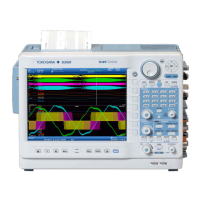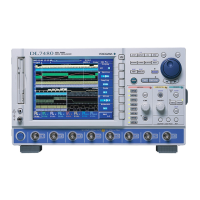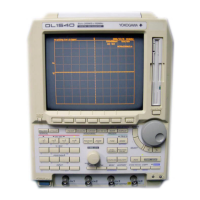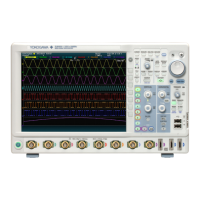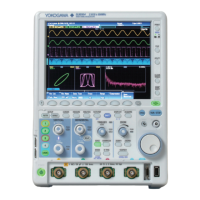3-10
IM DLM6054-01EN
About Probes
Specification of standard supplied probe (model 701943), after probe phase
compensation
Item Specification Conditions
Overall probe length 1.3 m —
Connector type BNC —
Input impedance
10 M
Ω
± 2%
Together with an oscilloscope of input
impedance 1 M
Ω
± 1%
Input capacitance Approx. 10.5 pF
Attenuation ratio Not exceeding 10:1 ± 2%
Bandwidth DC to 500 MHz
(not exceeding –3 dB)
Rise time 700 ps or less (typical
*
)
Maximum input voltage 600 V (DC+ACpeak) or 424 Vrms When AC does not exceed 100 kHz
* T
ypical values are typical or mean values. They are not strictly guaranteed.
Precautions to Be Taken When Using Voltage Probes Other Than Those Provided
with the Instrument
• When measuring a signal including a frequency close to 500 MHz, use a probe with a frequency
range above 500 MHz.
• Measurement will only be correct if the attenuation ratio is set
properly. Check the attenuation
ration of the probe that you are using and set it properly.
Setting the Probe Attenuation Ratio or Voltage-Current Conversion Factor
When using a probe not supported by the probe interface connector, follow the procedure described
in Section 6.6 to set the DL6000/DLM6000 attenuation ratio or voltage-current conversion factor to
match the probe attenuation ratio or voltage-current conversion factor. If this setting is not carried
out, correct measurement values will not be displayed.
Connecting a Probe Supported by the Probe Interface Connector
• If you connect a probe* supported by the probe interface connector to the DL6000/DLM6000, the
probe type is automatically recognized, and the attenuation ratio set. Power is supplied to the probe
through the probe interface, and therefore it is not necessary to connect the probe power cable to
the probe power terminals.
• Y
ou can execute automatic zero adjustment (see section 5.1) on a current probe that is compatible
with the probe interface connector.
* For a list of compatible probes, see “Optional Accessories” on page v.
Connecting FET Probe, Current Probe, Differential Probe, or
Deskew Correction Signal Source
If you are using the YOKOGAWA’s FET Probes, Current Probes, Differential Probes, or Deskew
Correction Signal Source, use the probe power terminal (option) on the DL6000/DLM6000 rear panel
for the power supply. For details on the connection procedure, see the manual that comes with the
respective product.
* For a list of probes and signal sources, see “Optional Accessories” on page v.
CAUTION
Do not use the Probe Power Terminal (option) on the DL6000/DLM6000 rear panel for
purposes other than supplying power to the FET Probe, Current Probe, Differential Probe, or
Deskew Correction Signal Source. Also, be sure that the total current of the four Probe Power
Terminals and the four Probe Interface Terminals does not exceed 1.2 A. Otherwise, the
device connected to the Probe Power Terminals or to the DL6000/DLM6000 may break.
* This applies to the DLM6000. For the DL6000, do not supply more than a total of 1.2 A to the two probe
power terminals and the four probe interface terminals.
3.4 Connecting the Probe

